1995 CHEVROLET SUBURBAN key
[x] Cancel search: keyPage 87 of 486
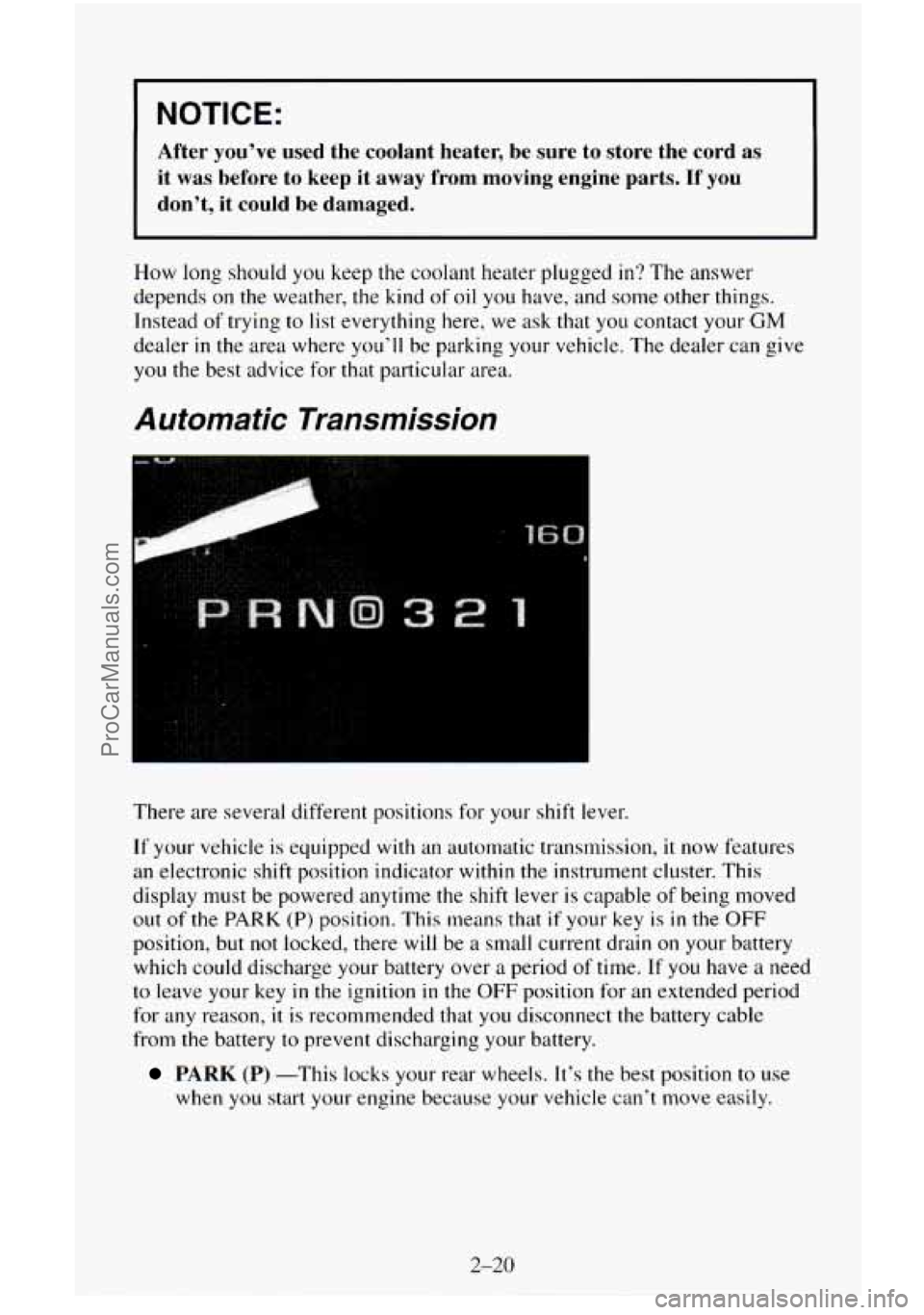
NOTICE:
After you’ve used the coolant heater, be sure to store the \
cord as
it
was before to keep it away from moving engine parts. If you
don’t, it could be damaged.
How long should you keep the coolant heater plugged in‘? The answer
depends on the weather, the kind of oil
you have, and some other things.
Instead of trying
to list everything here, we ask that you contact your GM
dealer in the area where you’ll be parking your vehicle. The dealer can give
you the best advice for that particular area.
Automatic Transmission
T
There are several different positions for your shift lever.
If your vehicle is equipped with an automatic transmission, it now features
an electronic shift position indicator within
the instrument cluster. This
display must be powered anytime the shift lever
is capable of being moved
out
of the PARK (P) position. This means that if your key is in the OFF
position, but not locked, there will be a small current drain on your battery
which could discharge your battery over a period of time. If you have a need
to leave your key
in the ignition in the OFF position for an extended period
for any reason,
it is recommended that you disconnect the battery cable
from the battery to prevent discharging your battery.
PARK (P) -This locks your rear wheels. It’s the best position to use
when you start your engine because your vehicle can’t move easily.
2-20
ProCarManuals.com
Page 95 of 486

3. If you have four-wheel drive, be sure the transfer case is in a drive gear
4. Move the ignition key to LOCK.
-not in NEUTRAL (N)
5. Remove the key and take it with you. If you can walk away from your
vehicle with the ignition key
in your hand, your vehicle is in PARK (P).
Shifting Out of PARK (P)
Your vehicle has a brake-transmission shift interlock system. You have to
fully apply your regular brakes before you can shift from PARK (P). See
“Automatic Transmission”
in the Index.
If
you cannot shift out of PARK (P), ease pressure on the shift lever and
push the shift lever all the way up into PARK
(P) as you maintain brake
application. Then, move the shift lever into the gear you want.
If
you ever hold the brake pedal down but still can’t shift out of PARK (P),
try this:
1. Turn the key to OFF.
2. Apply and hold the brake until the end of Step 4.
3. Shift to NEUTRAL (N).
4. Start the vehicle and then shift to the drive gear you want.
5. Have the brake-transmission shift interlock system fixed as soon as
you can.
Leaving Your Vehicle With the Engine Running
(Automatic Transmission
Models Only)
It can be dangerous to leave your vehicle with the engine
running. Your vehicle could move suddenly if the shift lever
is
not fully in PARK (P) with the parking brake firmly set. If you
have four-wheel drive with
a manual transfer case shift lever
and your transfer case
is in NEUTRAL (N), your vehicle will be
free to roll, even if your shift lever
is in PARK (P). So be sure the
transfer case is in
a drive gear - not in NEUTRAL (N). And, if
you leave the vehicle with the engine running, it could overheat
and even catch
fire. You or others could be injured. Don’t leave
your vehicle with the engine running unless you have to.
2-28
ProCarManuals.com
Page 137 of 486
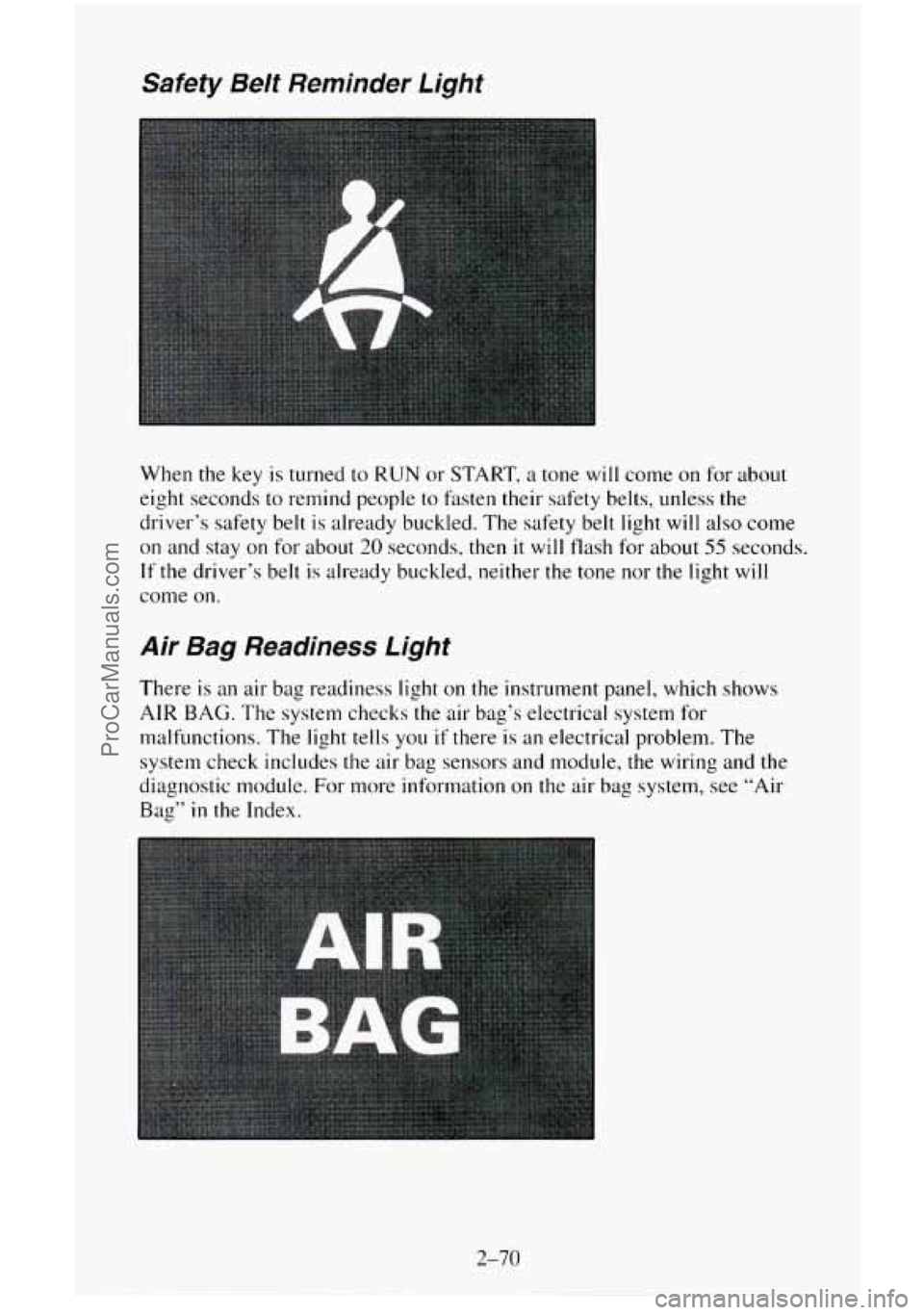
Safety Belt Reminder Light
When the key is turned to RUN or START, a tone will come on for about
eight seconds to remind people to fasten their safety belts, unless the
driver’s safety belt is already buckled. The safety belt light will also come
on and stay on for about 20 seconds, then it will flash for about 55 seconds.
If the driver’s belt is already buckled, neither the tone nor the light will
come on.
Air Bag Readiness Light
There is an air bag readiness light on the instrument panel, which shows
AIR BAG. The system checks the air bag’s electrical system for
malfunctions. The light tells you
if there is an electrical problem. The
system check includes the air bag sensors and module, the wiring and the
diagnostic module. For more information
on the air bag system, see “Air
Bag” in the Index.
2-70
ProCarManuals.com
Page 186 of 486
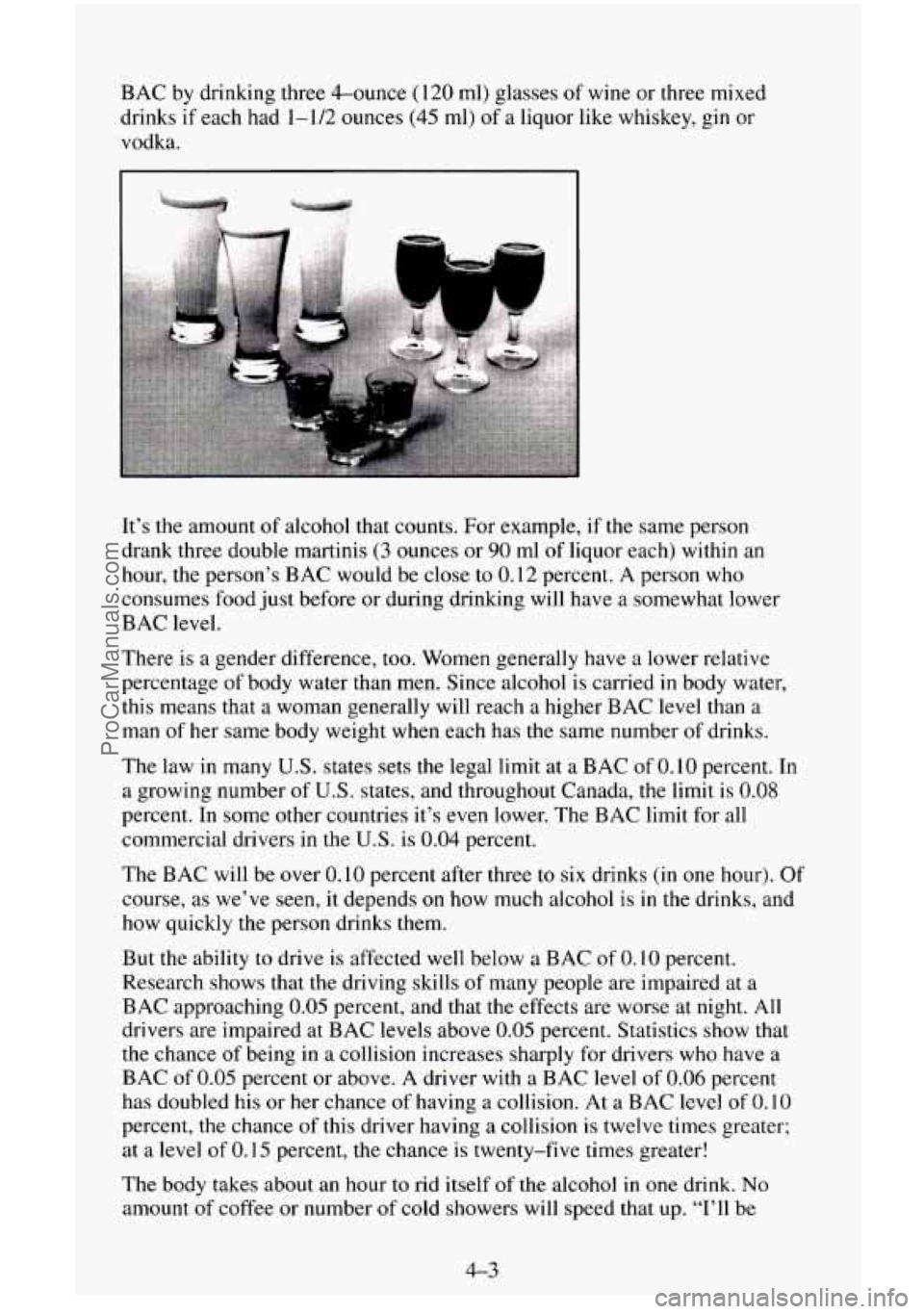
BAC by drinking three 4-ounce ( 120 ml) glasses of wine or three mixed
drinks
if each had 1-1/2 ounces (45 ml) of a liquor like whiskey, gin or
vodka.
It’s the amount of alcohol that counts. For example, if the same person
drank three double martinis
(3 ounces or 90 ml of liquor each) within an
hour, the person’s BAC would be close to
0.12 percent. A person who
consumes food just before or during drinking will have a somewhat lower
BAC level.
There is a gender difference, too. Women generally have a lower relative
percentage
of body water than men. Since alcohol is carried in body water,
this means that a woman generally will reach a higher BAC level than a
man of her same body weight when each has the same number
of drinks.
The law in many
U.S. states sets the legal limit at a BAC of 0.10 percent. In
a growing number of U.S. states, and throughout Canada, the limit is 0.08
percent. In some other countries it’s even lower. The BAC limit for all
commercial drivers in the
U.S. is 0.04 percent.
The BAC will be over 0.10 percent after three to six drinks (in one hour). Of
course, as we’ve seen, it depends on how much alcohol is in the drinks, and
how quickly the person drinks them.
But the ability to drive
is affected well below a BAC of 0.10 percent.
Research shows that the driving skills of many people are impaired at a
BAC approaching
0.05 percent, and that the effects are worse at night. All
drivers are impaired
at BAC levels above 0.05 percent. Statistics show that
the chance of being
in a collision increases sharply for drivers who have a
BAC
of 0.05 percent or above. A driver with a BAC level of 0.06 percent
has doubled his or her chance of having a collision. At a BAC level
of 0.10
percent, the chance
of this driver having a collision is twelve times greater;
at a
level of 0.15 percent, the chance is twenty-five times greater!
The body takes about an hour
to rid itself of the alcohol in one drink. No
amount of coffee or number of cold showers will speed that up. “1’11 be
4-3
ProCarManuals.com
Page 197 of 486
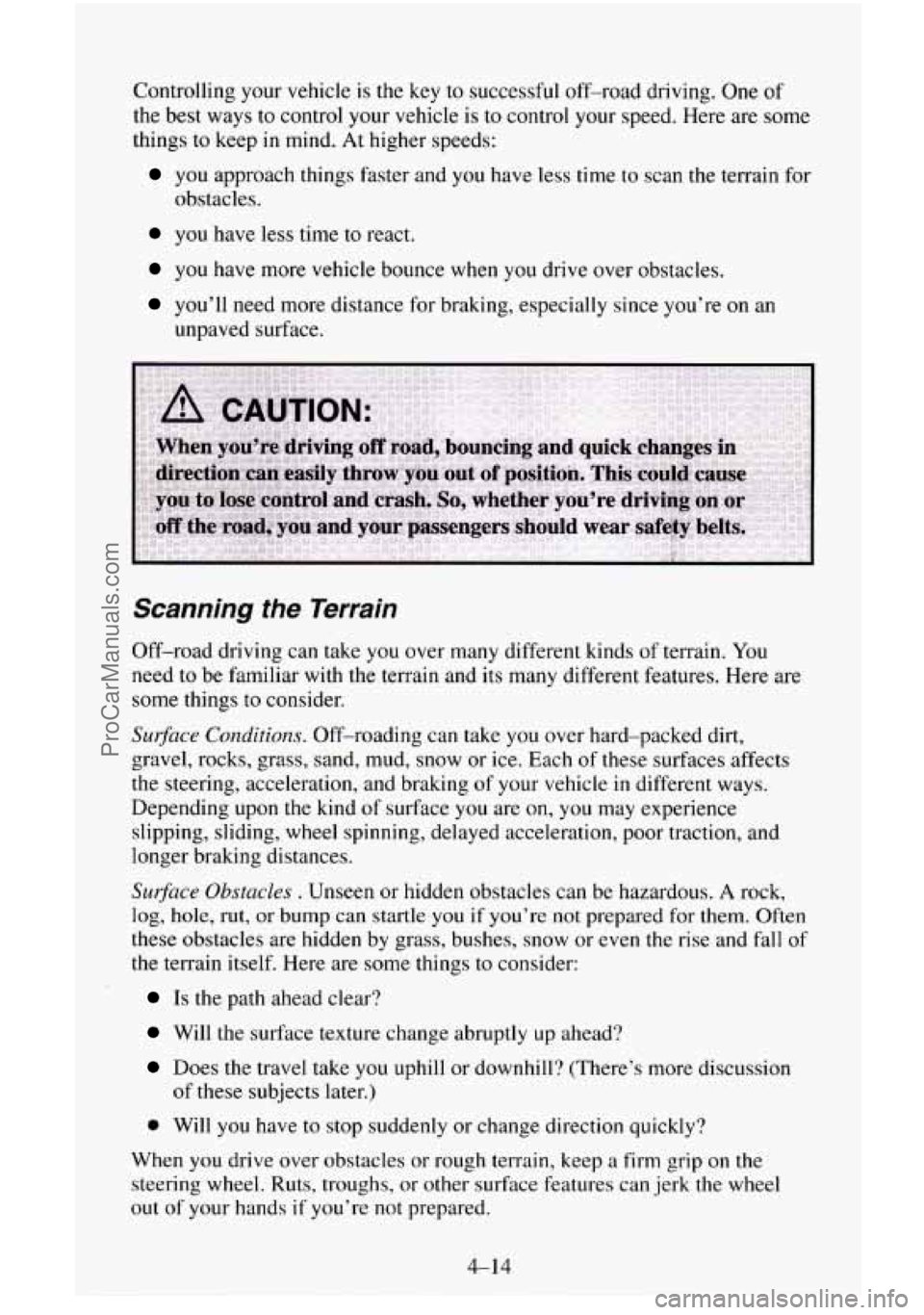
Controlling your vehicle is the key to successful off-road driving. One of
the best ways to control your vehicle is to control your speed. Here are some
things to keep
in mind. At higher speeds:
you approach things faster and you have less time to scan the terrain for
obstacles.
you have less time to react.
you have more vehicle bounce when you drive over obstacles.
you’ll need more distance for braking, especially since you’re on an
unpaved surface.
Scanning the Terrain
Off-road driving can take you over many different kinds of terrain. You
need to be familiar with the terrain and its many different features. Here are
some things to consider.
Surface Cunditiuns. Off-roading can take you over hard-packed dirt,
gravel, rocks, grass, sand, mud, snow or ice. Each
of these surfaces affects
the steering, acceleration, and braking of your vehicle in different ways.
Depending upon the kind
of surface you are on, you may experience
slipping, sliding,
wheel spinning, delayed acceleration, poor traction, and
longer braking distances.
Surface Obstacles . Unseen or hidden obstacles can be hazardous. A rock,
log, hole, rut, or bump can startle you if you’re not prepared for them. Often
these obstacles are hidden by grass, bushes, snow or even the rise and fall
of
the terrain itself. Here are some things to consider:
Is the path ahead clear?
Will the surface texture change abruptly up ahead?
Does the travel take you uphill or downhill? (There’s more discussion
of these subjects later.)
0 Will you have to stop suddenly or change direction quickly?
When you drive over obstacles or rough terrain, keep a firm grip
on the
steering wheel. Ruts, troughs, or other surface features can jerk the wheel
out
of your hands if you’re not prepared.
4-14
ProCarManuals.com
Page 235 of 486

Push the button at the
top
of the steering
column all the way
down to make your
front and rear turn
signals flash on and
off.
Your hazard warning flashers work
no matter what position your key is in,
and even if the key isn’t
in.
To turn off the flashers, push the button until the first click and release.
When the hazard warning flashers are
on, your turn signals won’t work.
Other Warning Devices
If you carry reflective triangles, you can set one up at the side of the road
about 300 feet (100 m) behind your vehicle.
Jump Starting
If your battery (or batteries) has run down, you may want to use another
vehicle and some jumper cables
to start your vehicle. But please follow the
steps below to do it safely.
5-2
ProCarManuals.com
Page 240 of 486
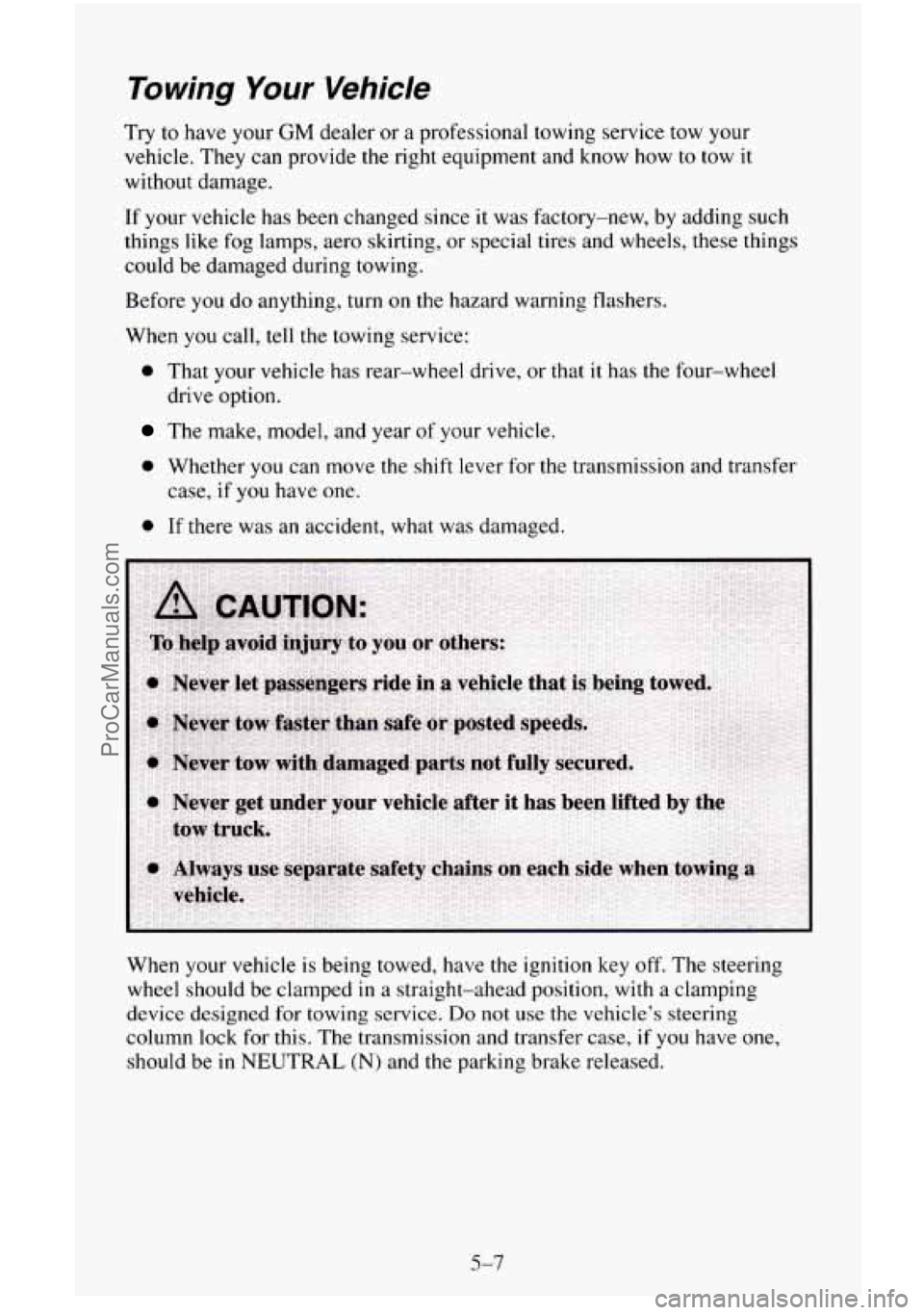
To wing Your Vehicle
Try to have your GM dealer or a professional towing service tow your
vehicle. They can provide the right equipment and know how
to tow it
without damage.
If your vehicle has been changed since it was factory-new, by adding such
things like fog lamps, aero skirting, or special tires and wheels, these things
could be damaged during towing.
Before you do anything, turn on the hazard warning flashers.
When you call, tell the towing service:
0 That your vehicle has rear-wheel drive, or that it has the four-wheel
drive option.
The make, model, and year of your vehicle.
0 Whether you can move the shift lever for the transmission and transfer
case, if you have one.
0 If there was an accident, what was damaged.
When your vehicle is being towed, have
the ignition key off. The steering
wheel should be clamped
in a straight-ahead position, with a clamping
device designed for towing service.
Do not use the vehicle’s steering
column
lock for this. The transmission and transfer case, if you have one,
should be in NEUTRAL (N) and the parking brake released.
5-7
ProCarManuals.com
Page 285 of 486
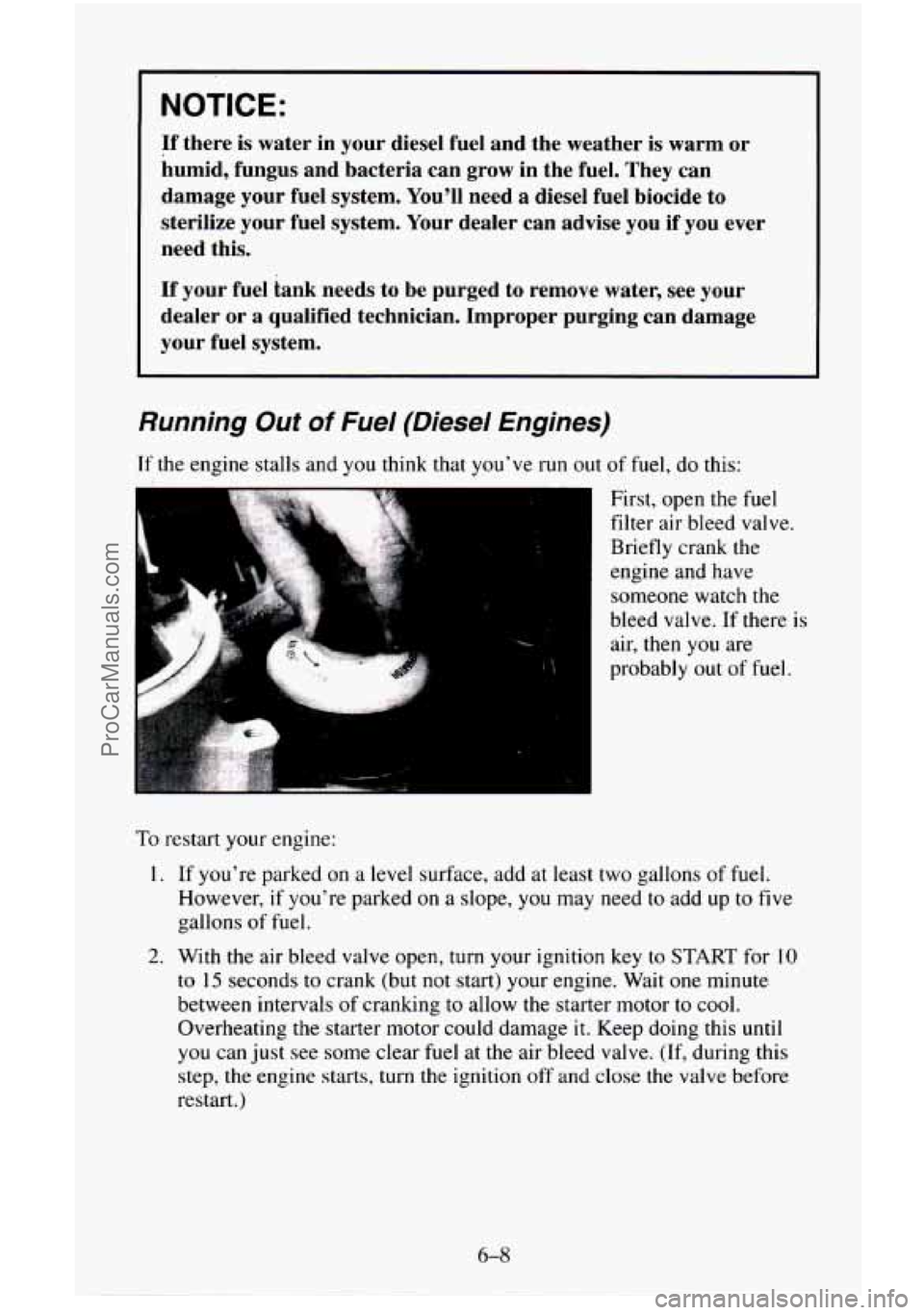
NOTICE:
If there is water in your diesel fuel and the weather is warm or
humid, fungus and bacteria can grow in the fuel. They can
damage your fuel system. You’ll need
a diesel fuel biocide to
sterilize your fuel system. Your dealer can advise you if you ever
need this.
If your fuel tank needs to be purged to remove water,
see your
dealer or
a qualified technician. Improper purging can damage
your fuel system.
Running Out of Fuel (Diesel Engines)
If the engine stalls and you think that you’ve run out of fuel, do this:
First, open the fuel
filter air bleed valve.
Briefly crank the
engine and have
someone watch
the
bleed valve. If there is
air,
then you are
probably
out of fuel.
To restart your engine:
1. If you’re parked on a level surface, add at least two gallons of fuel.
However, if you’re parked on a slope, you may need to add up to five
gallons of fuel.
2. With the air bleed valve open, turn your ignition key to START for 10
to 15 seconds to crank (but not start) your engine. Wait one minute
between intervals of cranking to allow the starter motor
to cool.
Overheating the starter motor could damage
it. Keep doing this until
you can just see some clear fuel at the air bleed valve. (If, during this
step, the engine starts, turn the ignition off and close the valve before
restart.)
ProCarManuals.com